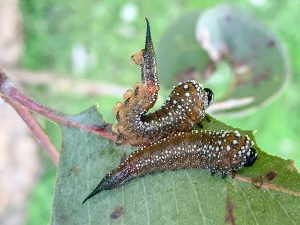By Jonathon Howard
Many insects survive on a diet of gum leaves. This is a food source low in nutrients. It also contains eucalyptol, an organic compound that is toxic in high doses as well as flavonoids (plant-based antioxidants), volatile oils, and tannins. So what enables insects to not just survive but thrive on such a diet?
If you thought of the sawfly when answering this question, your answer would be that some insects store the toxic Eucalyptus oil inside their body and use it for their own defence. When disturbed, sawfly larvae tap their abdomens up and down and regurgitate the Eucalyptus oil as thick yellow fluid- which has been shown the deter ants and other predators.
But that response does not answer the question about what ‘enables’ the insect to eat the leaves. Part of that answer is that many insects have the right ‘weaponry’. The cell wall of a leaf can be difficult to digest or chemically crack open. So many insects rely on ‘mechanical’ disruption to do so. That is, their head and jaws are built strong enough to crack open a cell wall.
Caterpillars replace their jaws at each moult, offering the potential for them to change their teeth each time. This means smaller heads and jaws facilitate selective feeding- such as at the leaf tips. Whereas larger heads and jaws allow the individual to be less fussy and consume greater quantities of leaf material not possible by younger and smaller caterpillars. It means caterpillars of different sizes do not compete for the same food source.
But its more complex than that, in some species the parts of the leaves that are eaten change. For example, some young caterpillars have a toothed cutting jaw, while older ones have a smoothed edge jaw. A smooth edge jaw spreads the force required to crack the leaf’s cell wall. This means as a caterpillar grows, it changes it feeding strategies from leaf mining, to skeletonising, and then finally leaf snipping. These changes to the jaw structure are partnered with larger heads which house large muscles capable of producing greater force.
While eucalypt leaves might not seem very nourishing, if you use them wisely, it enables you to protect yourself from predators and avoid competition from your brothers and sisters. No wonder it’s a food source enjoyed by many of the six legged creatures in this world.


